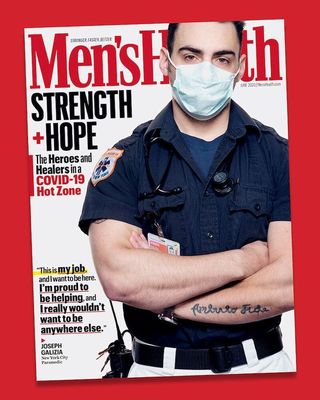
Intermittent fasting, the diet plan where you only eat within an allotted window of time each day, has become an incredibly popular means of weight loss. Advocates of this approach include star CrossFit athlete Rich Froning, who credits the diet with “transforming” his training, and actor Kumail Nanjiani, who says intermittent fasting helped him a lot when he was getting ripped for Marvel’s Eternals.

Men’s Health
Subscribe to Men’s Health
SHOP NOW
YouTuber Edward V, aka Fledge Fitness, has been intermittent fasting for seven years. He first started in January 2013 as a New Year’s Resolution; he weighed approximately 230 pounds, and while he had lost weight through myriad other diets, and would then soon gain the weight back after a little while. “I’m not good at creating a specific foods diet system,” he says, “and that’s why intermittent fasting, in which the main focus is timing, was much easier for me.”
After just one month, Edward was pleased with the weight loss results he was seeing. “Not only that, but I was breaking through weight barriers I wasn’t able to break through using all these other diet protocols,” he says.
For the majority of the time that he has been intermittent fasting, Edward has specifically been sticking to the “warrior diet,” which involves eating in a four-hour window, with a 20-hour fasting window. “Even if I hit some kind of a wall or a plateau, I never actually changed my baseline protocol,” he says.
He adds that he stuck to the 20 hours of fasting and the four hours of eating because that suited him personally. However you approach it, intermittent fasting has to work for you and your needs personally — and it has to be sustainable. “Losing weight is just losing weight, you can lose weight in two months,” he says. “It’s what you can replicate on a daily basis for the rest of your life that’s going to make it work for you.”
As time passed, Edward introduced new variables into the fasting, such as adopting the one meal a day (OMAD) diet so that he would only eat once during his four hour window.
Even if only eating once a day, though, Edward’s weight would fluctuate as he bulked and cut during his training. “I haven’t been a steady weight, but I’ve never gone back up to 230 pounds,” he says. “I’ll go up, build a little bit of muscle, then lean down again.”
Throughout the seven years Edward kept close track of his caloric intake. “Calories matter, but it’s the calorie partitioning that also matters,” he says, claiming that his muscle retention and ability to burn fat have improved as a result of the hormonal elements of a caloric deficit.
“While you might feel intense hunger in the beginning, that’s only because you’re snapping your body’s biological rhythm,” he says. “Adrenaline is released when you would usually eat breakfast, lunch and dinner. So it takes around two or three weeks for your body to adjust to the new eating window, and then you tend to get hungry when you’re about to hit that window.”
After doing it for so long, Edward says that he hardly ever even feels hungry any more — and adds that he will definitely continue with intermittent fasting for the next seven years.
Source: Read Full Article